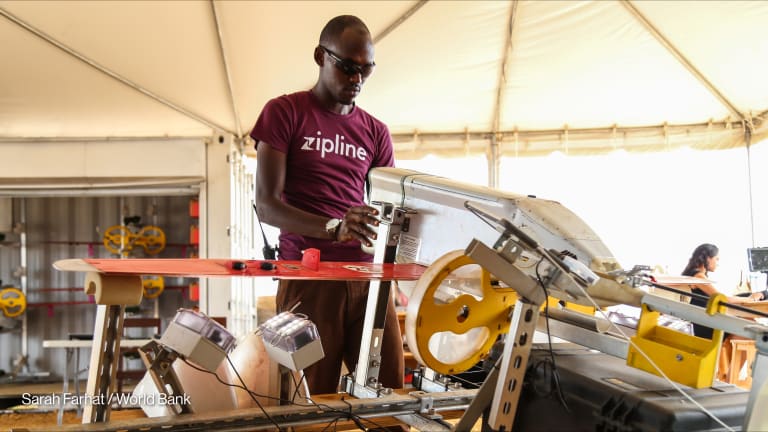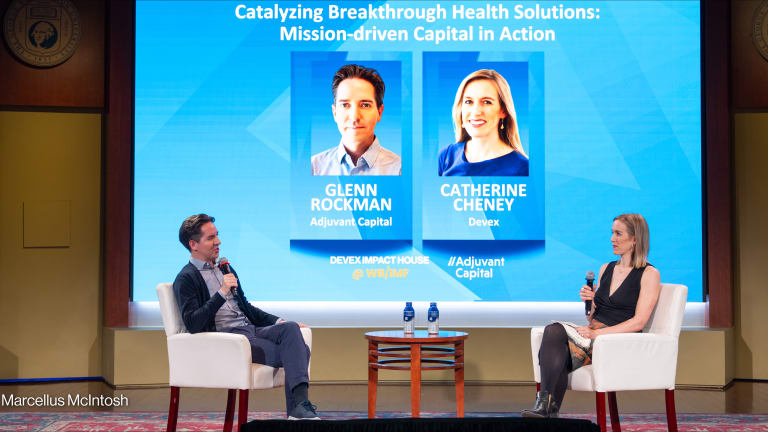Q&A: How Chemonics went from corrective action to commercial solutions
Devex speaks with Jamey Butcher, incoming CEO of Chemonics International, about how the USAID contractor responded to early challenges with the $9.5 billion global health supply chain project.
WASHINGTON — In 2015, the development contractor Chemonics International sent shockwaves through the U.S. aid community when it captured the largest U.S. Agency for International Development contract ever awarded and took control of a global health supply chain that undergirds the U.S. government’s largest health programs. Two years later, Chemonics’ success appeared to have turned against it. By the spring of 2017, as Devex first reported, the indicators used to track the performance of the supply chain had declined precipitously, prompting an intervention by USAID, a U.S. congressional hearing, and intensive corrective action by the contractor itself. Today, Chemonics’ leaders say they have delivered the kind of supply chain they originally imagined — and promised to USAID — and they say the supply chain is now delivering commercially-competitive results month after month. According to Chemonics, as of March 2019, the project had achieved $90 million in cost savings. “It's substantially more, but that amount has been looked at and scrutinized to a high degree and is verified as actual savings,” said Chemonics Executive Vice President Jamey Butcher, who currently oversees the $9.5 billion supply chain project, and will take over as the company’s CEO on April 1, 2020. Devex spoke to Butcher about how Chemonics responded to the project’s early challenges, how the supply chain project has evolved since then, and what the experience taught him about leading a major development contractor. This conversation has been edited for clarity and length: At a fundamental level, what do you think went wrong in the early stages of this project? Really there were three [issues]. One is that we were transitioning two previous programs into one [procurement and supply chain management] contract, and in that there were some challenges with that transition. We weren't receiving all of the data we needed. We had an expectation of a collaborative handover, and it just didn't happen. “In that well-documented space, we've made the changes to turn around that failing aspect of the program, but there are a multitude of other areas that went absolutely according to plan.” --— Jamey Butcher, executive vice president, Chemonics Second, we laid out a [management information] system that we had planned to build from day one, and in fact when we started the program we were told, let's take a step back and let's re-blueprint the system — [known as] ARTMIS. We did that, and we were able to meet our targets, but that meant that we delivered that system over three phases and went live with it in July 2017. And then we made the mistake — and I think this is the main lesson I've learned — that we didn't put our data into the system as it was being brought online, and so we didn't have a source of truth sitting there that allowed us to scrutinize the records and the deliveries in the way that we felt like we should have… So I think if I really had to boil it down, the area where we have the responsibility, and where we've taken responsibility and corrected, and what's really led to this result, is around that data and data visibility piece. Why the hesitation initially to input data as the system was coming online? It's a complex supply chain. There's a lot of pieces that had to come together, and people were working extraordinary hours to bring the supply chain together, and in doing that had created their data sets that they got used to. And there was a leadership failure in terms of our response initially that we then corrected, and got into it and said, actually we need to put this data in the system, and we need to clean it and make sure it's consistent and accurate. I think the early narrative around the project was that Chemonics promised a lot in the proposal, and then the early experience of the project was one of failing to deliver. To what extent were you learning as you went, as opposed to having those pieces in place on day one when the project started? I actually would challenge your characterization as a project that failed to deliver in the early stages. I agree with you — there was an area where we were unable to achieve our targets. We have a [performance management plan] which is published with a multitude of targets, not just on-time delivery. And so I think that characterization is not sufficient. To your question of whether we planned and learned as we went or started on day one, the experience of Chemonics as one of the largest, if not the largest, USAID contractor, together with commercial solutions providers like McKinsey, and IBM, and Kuehne and Nagel — leaders in their fields — means that we started on day one with all of the tools we needed at our disposal to implement a supply chain that had an ability to evolve into what we have today. I wouldn't say on day one that the supply chain itself was running in a commercial fashion, because it was still, for the first nine months of the program, being transitioned over, and we didn't actually even start deliveries that we initiated until nine, 10 months after the program began. So here we are a couple of years later talking about meeting and exceeding targets that are commercially aligned, providing a [management information] system that's cloud-based, where people around the world are able to access and place orders in that system with component parts that are used by the leading Fortune 500 companies. I can't give you a “yes” or “no.” It's a proposal that had a very detailed timeline in it, with a detailed transition plan, with agreed to targets and milestones, of which we failed to meet our on-time delivery targets ... In that well-documented space, we've made the changes to turn around that failing aspect of the program, but there are a multitude of other areas that went absolutely according to plan. Where we're at now, for me, is exciting, because now the U.S. government has, in this very important area of investment for foreign assistance, a platform that they can use in the future to achieve some of the longer-term goals that Administrator [Mark] Green has laid out. How would you characterize the basic differences between the supply chain that existed before Chemonics got involved in this line of work with USAID and the supply chain that you're operating now? I would just say we've evolved into a more commercial operation, and in that these cost savings have come through. I think the other thing is that we're harnessing the power of the global fleet of logistics providers and warehouse providers and others out there ... As one of the largest USAID contractors we compete and manage subcontractors and partners, and that is really what this approach entails. We had to do a lot of analytics and work at looking at where we could achieve cost savings and still provide high, if not higher, quality than was achieved previously. What do you mean by a “commercial operation,” exactly? The biggest difference is the end to end data visibility with the tools to operate in the most efficient manner possible. We started a frontier economy logistics lab with Arizona State University, which is one of our partners, with the express intent of adapting commercial solutions into developing country contexts. [Chemonics Senior Vice President] Chris Scott and I are both on the Supply Chain Executive Council — we sit with other companies like Dell and Intel, Starbucks and others, as well as our partners here — IBM, Kuehne and Nagel, others — and continually compare and benchmark our performance against theirs, and look at the tools, the different approaches, systems, methodologies they take in managing their supply chains, and are actively working to adapt them into ours. You're right to ask, what do we mean by “commercial.” It's just a throwaway word really, but for me, it's adapting private sector solutions into the developing countries’ supply chains that we're managing ... We're investing our own money and our own time in trying to push that envelope. We really believe that's the future, and I think [USAID’s] private sector engagement policy reflects that as well. Is the idea of managing a global supply chain consistent with PEPFAR's goal of channeling 70% of its funding through host country organizations? Absolutely. In fact we're doing procurement through the local professional staff we have in 10 countries. We call it decentralized procurement. Our system is set up in a way that allows them to do it, but it's also building that human capacity as well, of people who, in the future, will be taking over supply chains and running them. To that point, we're not just investing in systems. We've invested in a minimasters program with Arizona State University. That minimasters program was set out to provide an accredited, affordable, accessible, and appropriate set of courses for supply chain professionals. We opened it up to our teams around the world. We ended up with 343 students in the first cohort that we offered, which is roughly 30% of our professionals, in 25 countries. It's taught at the graduate level by one of our nation's leading supply chain schools. So why do we do that? It's not just about building systems so that we can move things today. It's building systems for tomorrow, and I'm really proud of that because it was a risk we took. It was an investment we made and we didn't know what kind of response we were going to get. We initially invested in the first 200 spots. Then right away we had 350 people signed up — largely local professional staff. “The commitment to our values and our culture as an organization was one of the single most important things we did in the early days of stepping in and getting things back on track.” --— How has the experience of this project changed how you think about Chemonics’ overall approach — on issues like business development, management, staffing? One of the most important things that I think we did is came in and looked at our operations and really recommitted back into our values of transparency and openness and admitting where we had problems and taking ownership and responsibility for it, focusing resources and investment — with really our CEO saying, “you have to fix this and do whatever it takes to fix it,” and moving rapidly in that manner, versus trying to hedge and trying to hope that things will get better. The commitment to our values and our culture as an organization was one of the single most important things we did in the early days of stepping in and getting things back on track. USAID submitted a negative performance review of Chemonics based on your initial performance. Do you think you've lost out on potential projects that you otherwise might have won? There's no way to know. The way that the proposal evaluation process works is, rightly, very tightly held. We don't know who's in the room. We know what the criteria are, and whether we've won or lost we receive a debrief. I'm sure, not just the CPARS [contractor performance assessment reporting system], but I would guess the news and everything surrounding the work we were doing may have caused pause for some of our USAID clients. I'm guessing that's true. I don't have any direct evidence but that's a natural conclusion. “I have yet to have something brought to me that shows that we are delivering anything less than what was delivered before.” --— I ask because Chemonic's leadership team made a decision to go after this project. Do you think that, in retrospect, that was the right decision? Has it been worth it? Yeah, absolutely. I'll tell you why. In 2004 we looked at [USAID’s Supply Chain Management System contract], and at that point decided we did not have the corporate capability to go after it, so we decided not to. We took a strategic, intentional approach of building up the capacity and experience that we needed, both from the past performance, but also the human capital skills side as well, and everything else in between that was needed to do the work. And now this actually shows. I have yet to have something brought to me that shows that we are delivering anything less than what was delivered before, and a lot of data to show that we're delivering a more exceptional service than has been received by the U.S. government previously. As you step into your new role as CEO, what do you hope to focus on, and where do you hope to take Chemonics? We're currently working on a strategy that will take us through the next three years starting during that transition, and we're finishing our current strategy. We're focusing very much on how we can truly empower our global workforce. This minimasters program is a good example of — how can we bring all of the work we do together to really empower the 80-90% staffing that we have that's local professional — in a world where we startup projects every year and we close them out every year and people come into our employment and then leave in three to five years and go on to do great things. Given the geographic disbursement of all of that staffing, it's not a small challenge. The other is around client service. How can we really take the what our values are around client service — excellence and innovation — to the next level? Both of those, in support of our mission, are really what we're looking at in our strategy.
WASHINGTON — In 2015, the development contractor Chemonics International sent shockwaves through the U.S. aid community when it captured the largest U.S. Agency for International Development contract ever awarded and took control of a global health supply chain that undergirds the U.S. government’s largest health programs.
Two years later, Chemonics’ success appeared to have turned against it. By the spring of 2017, as Devex first reported, the indicators used to track the performance of the supply chain had declined precipitously, prompting an intervention by USAID, a U.S. congressional hearing, and intensive corrective action by the contractor itself.
Today, Chemonics’ leaders say they have delivered the kind of supply chain they originally imagined — and promised to USAID — and they say the supply chain is now delivering commercially-competitive results month after month. According to Chemonics, as of March 2019, the project had achieved $90 million in cost savings.
This story is forDevex Promembers
Unlock this story now with a 15-day free trial of Devex Pro.
With a Devex Pro subscription you'll get access to deeper analysis and exclusive insights from our reporters and analysts.
Start my free trialRequest a group subscription Printing articles to share with others is a breach of our terms and conditions and copyright policy. Please use the sharing options on the left side of the article. Devex Pro members may share up to 10 articles per month using the Pro share tool ( ).
Michael Igoe is a Senior Reporter with Devex, based in Washington, D.C. He covers U.S. foreign aid, global health, climate change, and development finance. Prior to joining Devex, Michael researched water management and climate change adaptation in post-Soviet Central Asia, where he also wrote for EurasiaNet. Michael earned his bachelor's degree from Bowdoin College, where he majored in Russian, and his master’s degree from the University of Montana, where he studied international conservation and development.








